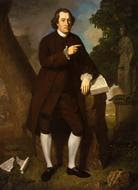Thursday, June 12, 2008
 John Beale Bordley, a Maryland planter and judge, raised the funds to send Charles Willson Peale to London, where the young artist trained under Benjamin West for two years. Bordley also helped Peale obtain his first major commission in America—two life-size portraits, including this allegorical work, that were to be shipped to London as declarations of colonial independence.
John Beale Bordley, a Maryland planter and judge, raised the funds to send Charles Willson Peale to London, where the young artist trained under Benjamin West for two years. Bordley also helped Peale obtain his first major commission in America—two life-size portraits, including this allegorical work, that were to be shipped to London as declarations of colonial independence. The theme of tyranny dominates the foreground. Trained as a lawyer, Bordley raises his hand in a gesture of debate. He points to a statue of British Liberty holding the scales of justice, reminding English viewers that the American colonists lived under British law and thus were entitled to the rights it guaranteed. Britain's violation of these rights is signified by the legal document, lying torn and discarded at Bordley's feet. Growing at the statue's base is jimsonweed, a poisonous plant, which serves to warn of the deadly consequences of any attack on American civil liberties.
America's agricultural self-sufficiency is referred to in the background, which depicts Bordley's plantation on Wye Island in the Chesapeake Bay, where Peale painted the canvas. A peach tree and a packhorse signify America's abundance, while the grazing sheep suggest freedom from reliance on imported British woolens.
Tajmahal Paintings

Painting Iteams

Creation of Paintings

Painting Equipments

Beautiful Rose Painting

Green Nature Painting

Canvas Painting

Pictute of Artist

Color Paintings

Online Paintings

0 comments:
Post a Comment